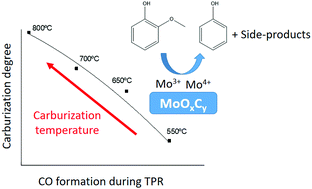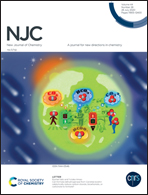Relevant aspects of the conversion of guaiacol as a model compound for bio-oil over supported molybdenum oxycarbide catalysts†
Abstract
Molybdenum supported over activated carbon has been carburized under carbothermal hydrogen reduction conditions at different temperatures in order to modify the carburization degree. The resulting catalysts were characterized by N2 physisorption, CO chemisorption, XPS, TPR, and TPD-NH3 and compared in the hydrodeoxygenation of guaiacol in a batch reactor as a lignin-derived model compound. The results have shown that the CO produced during the TPR could be related to the CO chemisorbed and the carburization degree of the material. The carburization degree was shown to increase with the final temperature, and under such conditions, two different Mo species, Mo4+ and Mo3+, were identified in the oxycarbide phase. Catalytic results showed that the Mo2C is less active than the oxycarbide MoOxCy phase. Mo2C showed to improvement in the transalkylation reactions while in the case of MoOxCy, Mo4+ promotes the hydrogenolysis of catechol to benzene while the Mo3+ species was shown to activate hydrogenation reactions.



 Please wait while we load your content...
Please wait while we load your content...